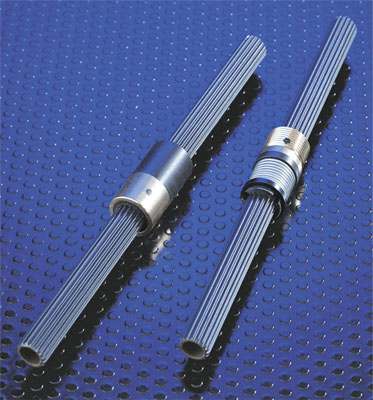By Edited by Leslie Langnau, Managing Editor
Pricing pressures, intense competition and strict regulatory demands are challenging scientists and researchers to make important breakthroughs faster and more efficiently, especially in such fast growing fields as the highly-regulated pharmaceutical industry, life science, biochemical, industrial, and environmental industries.
In scientific labs, the ability to analyze more samples in a given time has become paramount for companies’ bottom lines. Waters Corporation, a leading manufacturer of liquid chromatography instruments, mass spectrometers, thermal analyzers and rheology instruments, understands this pressure first hand. As a supplier to analytical laboratories around the world, Waters provides inventive devices that help scientists better understand the secrets of chemistry and life itself.
The Acquity Ultra Performance Liquid Chromatography™ (UPLC) is one such device. UPLC is an improvement over the widely accepted chemical separation technique — High Performance Liquid Chromatography (HPLC) — because it offers increased resolution, sensitivity, and speed, all of which give scientists considerably more information in a single run.

To create a
compact, stackable liquid chromatography separation device, engineers
needed to use small internal components. The completed system can
consist of a sample manager, one of several UPLC detectors, and a high-
pressure pump.
The new device uses the power of 1.7-micron particles for as much as nine times more throughput, three times higher routine sensitivity, and two times greater resolution or peak capacity than typical HPLC instruments can achieve with larger particles. In addition, the UPLC analyzes samples in 15 seconds, instead of the typical 60 seconds of HPLC devices. Multiply this time savings by millions of samples, and laboratories can see a hefty savings in process time.
As with most breakthrough products, though, the development of UPLC did not come without challenges. This device needed considerable collaboration on many levels.
The performance of the Acquity system was important to the product engineers, but it was not their sole design criterion. Management envisioned a system with a smaller footprint than traditional HPLC systems, so that it would consume less of a laboratory’s valuable bench space. The compact size would also guarantee that users could more easily stack and arrange the various modules. The engineers hoped that the completed basic system would consist of a sample manager, one of several UPLC detectors, and a high-pressure pump. Upgrades would also be available, including a high-capacity sample organizer.
This goal required the use of smaller internal components in both the main unit and the optional module, which holds an additional 21 sample plates. First efforts to create the required parts did not yield the desired results, according to Ken Plant, a principal engineer on the project.
“We initially attempted to devise a homemade solution, an adaptation of a mechanism we had developed about eight years ago,” he explained. “That mechanism created an XYZ movement to replace our traditional Z/Rotational movement and had served us quite well in our older models. However, this system of off-the-shelf pulleys and belts simply could not be squeezed into the smaller footprint we needed. If it was going to happen, we knew it would require some truly ‘out of the box’ thinking.
“More to the point, it became clear that in our effort to produce this compact mechanism, we could benefit from the use of specialized outside resources.”

In the
optional sample organizer, a 1/2-in. lead screw and anti-backlash nut
produces the Z axis motion, allowing the robotic machine to shuttle as
many as 21 sample plates back and forth to the sample manager.
One of Plant’s colleagues had worked with Kerk Motion Products when he was involved in the automation industry, and he felt that it might be able to offer the optimal combination of reliability and miniaturization for this mechanism.
After consulting with Waters’ engineers, Kerk engineers presented them with components to produce a sample manager – the heart of the UPLC system – that would meet the company’s reduced size requirements as well as the increased speed and performance vital to the concept.
“We considered several vendors, but Kerk had the best set of performance data,” said Plant. “While other vendors were selling off the shelf commodity items, Kerk’s engineers impressed us with their willingness to work with our engineers to customize their components and ensure that they would mesh into our system.”
Within the sample manager, Kerk components drive the robotic XYZ mechanism holding the needle that draws liquid samples from each sample plate. To achieve the “X” and “Y” movements, the Acquity arm uses one 1/4-in. lead screw and two specially adapted nuts, and the “Z” motion is handled through two spline shafts and splined bushings.
In the optional sample organizer, a 1/2-in. lead screw and anti-backlash nut produces the Z axis motion, allowing the robotic machine to shuttle as many as 21 sample plates back and forth to the sample manager.
The spline shafts, which run parallel to each other and feature custom splined bushings, provide a drive mechanism for two axes of motion. They are excellent alternatives for applications where hex shafts or square shafts are used (Waters’ original mechanism used square shafts). The assembly used lightweight alloy steel spline shafts treated with a proprietary low friction Kerkote® TFE coating mated with Kerkite® composite polymer bushings.
It wasn’t simply performance or size that made these components so desirable. “Their products also offer long wear-life,” Plant said. “This was a critical consideration, as our chromatography systems need to operate at a very high level of reliability. Continuous uptime is important to most of our customers.” The success of this system is reflected in the sales figures; Waters has sold 1000 of the core units, and expects to more than double that number in 2006.
This once again proves that good things do indeed come in small packages.

Kerk Motion
www.kerkmotion.com
:: Design World ::
Filed Under: Motion control • motor controls





Tell Us What You Think!